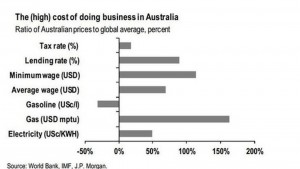The Australian Economy Carries Significant Downside Risk
Last week I wrote about the unhealthy dominance of banks in the Australian economy. In fact, the financial sector is almost half of the market capitalisation of all listed companies. There are other issues in the Australian economy that could prove exceedingly risky on the downside.
Australia’s deficit as a percentage of GDP is currently around 2%, which is small compared with other OECD countries. For example the number is around 10% for Japan and around 7% for the US.
However, Australia has run deficits since 2009. That is, during the greatest mining boom anyone now alive has seen, or probably ever will see. We will not even approach a surplus anytime soon if we couldn’t during the mining boom. My pick is that the deficit will continue to grow.
The collapse in mineral and energy prices has, and will, dramatically curtail government revenue. The current government is making noises about increasing taxes to make up the difference, but we hear very little about reform to bloated bureaucracies and excessive regulation.
Australia is already a very highly taxed country, with many taxes over and above income tax. For example, at dollar parity, a car that cost $90,000 in the US would cost $160,000 in Australia. The difference is all tax.
Australia is a very expensive place to do business. The chart below says it all. It is from an excellent report by Stephen Walters, a JP Morgan analyst. He concludes that Australia is “sliding down the precipice”.
There is no depth to the economy; the IT, Industrial, Telco and Healthcare/Biotech sectors are small parts of the overall market. Telecommunications is dominated by one player, Telstra, which was once a government-owned monopoly. It is profitable and pays a dividend but is barely growing. It has no real competition.
Australia manufactures very little. An oil refinery seem to close every month and very soon car manufacturing will cease.
It is a similar story in the consumer space. The Consumer Staples sector is dominated by two supermarket chains. Woolworths and Coles. Their market dominance is a significant barrier to entry and they can, and do, monster their suppliers.
The only real growth story in Australia is residential real estate. Construction is booming, particularly with apartments, where most sales are to domestic and foreign investors. Australian real estate is expensive by any metric. A slowing of this market will put great strain on the economy. Any sort of collapse would be catastrophic.
Conclusion
The Australian stock market is at its highest level since 2009. Beware of the catalyst that exposes the fragile underpinnings of this market.

